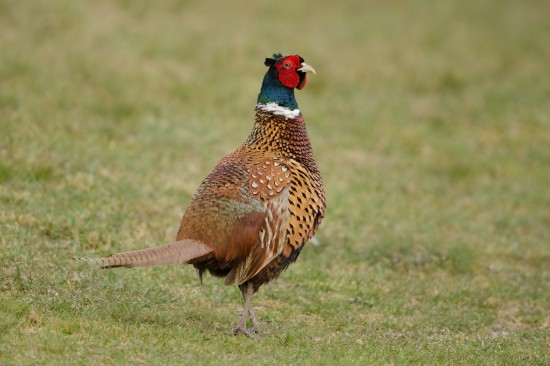
Three fish for your freshwater tank are described here; Scientific names, preferred conditions, colors description, sex differences and breeding advice are given for the Firemouth Panchax - Epiplatys chaperi (Family: Cyprinodontidae), the Giant Danio - Danio aequipinnatus (Family: Cyprinidae) and the Half-beak, Dermogenys pusillus (Family: Exocoetidae)
Firemouth Panchax - Epiplatys chaperi (Family: Cyprinodontidae)
Often called the firemouth killie there are other members of the genus which are less popular but also suitable for your aquarium. There is the Epiplatys fasciolatus (banded or striped killie), the Epiplatys macrostigma (large spotted killie) and the Epiplatys annulatus (clown killie).
For the firemouth panchax the water should be between 24 and 28 degrees centigrade and slightly alkaline. It is a good looking, peaceful fish that prefers the majority of its feed as live food. As its name suggests it has a bright red lower lip and throat. That is why it is also called the Redjaw killie. Males are brighter in color than females and have a pointed bit on their caudal fin.
A breeding tank will be planted and have floating plants. Two females will be located in the tank prior to the male. Eggs are laid and spawned individually so it can be seven days before spawning is finished and then the eggs must be collected up and placed in another tank to hatch under low light conditions. It can be about fourteen days before the fry hatch.
Giant Danio - Danio aequipinnatus (Family: Cyprinidae)
Because it can grow up to 12 cms you need to select your other community tank inhabitants with their size in mind as it could frighten small fish, although it is peaceful. It swims fast and compared to others it will last for a long time. And in its genus is the biggest fish. A varied diet is adequate for it meaning a mixture of dried and live foods.
Fins become reddish in a breeding situation. The flanks of the fish have horizontal pale blue bands with yellow separations. It has a pinkish underneath and the back varies from blue to green. The mouth protrudes and has a pair of barbels normally. The differences between the sexes are; the male has a brighter color, its horizontal bands are less broken up and its lower jaw extends more than the female.
For breeding, put a giant danio with a swollen body (female with eggs) and one that has not got a swollen body (male) into a breeding tank where spawning will automatically follow. The tank must be thickly planted and oxygenated by plants or mechanical means. Over 200 tiny sticky eggs may be laid. You then have two choices; remove the fish or remove the eggs to a tank at the same temperature. Fry should hatch after about three days. Feed with infusoria and micro-worms initially.
Half-beak, Dermogenys pusillus (Family: Exocoetidae)
An aquarium at about 27 degrees centigrade is required with floating plants and the tank must be covered. Although 'peaceful' the males practice mock fighting and this may cause other fish to be frightened. The half-beak's main feature is its lower jaw which extends well in front of the upper jaw. And another feature is its dislike of dried foods in its diet.
The adult male grows to over 7 cms and the females are even bigger. The fish has small reddish tinted fins on its long slim body which is white underneath, olive brown on the top and pale olive on the flanks. It is not that easy to tell the differences between the sexes. Miscarriages are quite common with this species and inadequate feeding is sited as the cause.
A breeding trap is required in the breeding tank as the female has a tendency to eat its own. The tank needs to be shallow, well planted and informed sources suggest a teaspoonful of salt added per five liters of water. As a live-bearer the half-beak will produce about 15 to 20 young after a pregnancy of about four weeks.
Feed the young with firstly, infusoria and micro-worms, secondly; brine shrimp and once its extended jaw develops then feed live insects.
So there you have it, three more fish for your freshwater tank and more mouths to feed. Just make sure that you have enough tank space to cater for your new additions.
Paul Curran is webmaster at Fresh-Water-Aquariums-Guide.com and provides a care information system for fresh water aquariums. Get your FREE E-Course on how to set up and maintain a beautiful aquarium, have the healthiest, happiest fish around AND learn about more fish for a freshwater tank
 What’s Biting - Seven Biting And Stinging Insects That May Target Your Dog
What’s Biting - S
What’s Biting - Seven Biting And Stinging Insects That May Target Your Dog
What’s Biting - S
 Breeds Of Pheasant
Breeds Of Pheasan
Breeds Of Pheasant
Breeds Of Pheasan
 Is The Tonkinese Cat More Affectionate Than The Siamese And The Burmese?
Is The Tonkinese
Is The Tonkinese Cat More Affectionate Than The Siamese And The Burmese?
Is The Tonkinese
 Playful Breeds Of Dogs
Playful Breeds Of
Playful Breeds Of Dogs
Playful Breeds Of
 Top Tips For Treating Ear Infections In Dogs And Cats
Top Tips For Trea
Top Tips For Treating Ear Infections In Dogs And Cats
Top Tips For Trea
Copyright © 2005-2016 Pet Information All Rights Reserved
Contact us: www162date@outlook.com